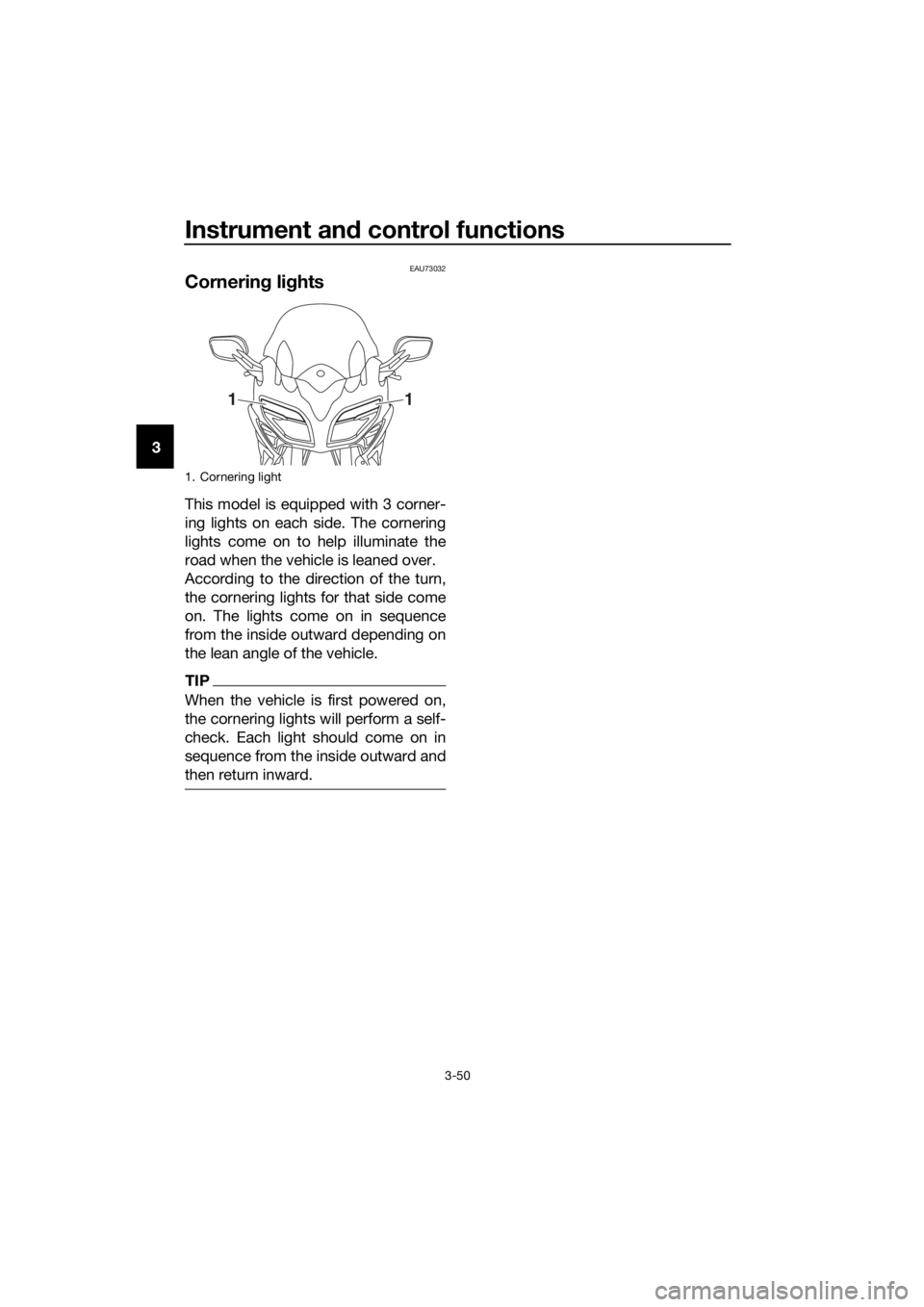2018 YAMAHA FJR1300AS light
[x] Cancel search: lightPage 62 of 122

Instrument and control functions
3-48
3
With the engine turned off:
1. Place vehicle on centerstand.
2. Move the sidestand down.
3. Set engine stop switch to run position.
4. Turn main switch to on position.
5. Shift transmission into neutral.
6. Apply the front or rear brake.
7. Push the start switch.
Does the engine start?
With the engine still running:
8. Move the sidestand up.
9. Apply the rear brake (to prevent a
TCS error).
10. Shift transmission into gear.
11. Move the sidestand down.
Does the engine stall?
After the engine has stalled:
12. Move the sidestand up.
13. Release the brake.
14. Push the start switch.
Does the engine start?
The system is OK. The motorcycle can
be ridden.
The neutral switch, a brake light switch
or the YCC-S system may not be
working.
The motorcycle should not be ridden
until checked by a Yamaha dealer.
The sidestand switch may not be
working.
The motorcycle should not be ridden
until checked by a Yamaha dealer.
A brake light switch may not be working.
The motorcycle should not be ridden
until checked by a Yamaha dealer.
WARNING
The vehicle must be placed on the centerstand during this inspection.
If a malfunction is found, have the vehicle inspected before riding.
YES NO
YESNO
NOYES
UB95E1E0.book Page 48 Tuesday, September 26, 2017 12:01 PM
Page 64 of 122

Instrument and control functions
3-50
3
EAU73032
Cornerin g lig hts
This model is equipped with 3 corner-
ing lights on each side. The cornering
lights come on to help illuminate the
road when the vehicle is leaned over.
According to the direction of the turn,
the cornering lights for that side come
on. The lights come on in sequence
from the inside outward depending on
the lean angle of the vehicle.
TIP
When the vehicle is first powered on,
the cornering lights will perform a self-
check. Each light should come on in
sequence from the inside outward and
then return inward.
1. Cornering light
11
UB95E1E0.book Page 50 Tuesday, September 26, 2017 12:01 PM
Page 68 of 122

Operation and important rid ing points
5-2
5
EAU55474
Startin g the en gine
WARNING
EWA16411
Always apply the front or rear brake
while the main switch is in the “ON”
position an d the transmission is in
g ear. Otherwise, the vehicle may
su ddenly start to move when the en-
g ine is started , causing loss of con-
trol and possibly an acci dent.
In order for the ignition circuit cut-off
system to enable starting, one of the
following conditions must be met:
The front or rear brake is applied
with the transmission in the neu-
tral position whether the sidestand
is up or down.
The front or rear brake is applied
with the transmission in gear and
the sidestand is up.
See page 3-47 for more informa-
tion.
1. Turn the key to “ON” and make sure that the engine stop switch is
set to “ ”.
The following lights should come
on for a few seconds, then go off. Oil level warning light
Engine trouble warning light
Traction control system indi-
cator light
Cruise control indicator lights
Suspension sy stem warning
light
Shift down indicator light
YCC-S system warning light
Stop mode indicator light
Immobilizer system indicator
light
TIP
If stop mode is turned on, then the
stop mode indicator light will re-
main on.
The ABS warning light should
come on and stay on until the ve-
hicle reaches a traveling speed of
10 km/h (6 mi/h).
NOTICE
ECA24110
If a warnin g or in dicator li ght does
not work as descri bed a bove, have a
Yamaha dealer check the vehicle.
2. Shift the transmission into neutral.
The neutral indicator light should
come on.
3. Apply the front or rear brake.
4. Push the start switch, and release it when the engine starts.
If the engine does not start within
5 seconds of pressing the start
switch, wait 10 seconds before
pressing the switch again to allow
the battery voltage to restore.
NOTICE
ECA11043
For maximum en gine life, never ac-
celerate har d when the en gine is
col d!
UB95E1E0.book Page 2 Tuesday, September 26, 2017 12:01 PM
Page 69 of 122

Operation and important ri din g points
5-3
5
EAU55482
Shiftin g
Shifting gears lets you control the
amount of engine power available for
starting off, accelerating, climbing hills,
etc.
The gears can be shifted using either
the shift pedal or the hand shift lever.
Refer to page 3-25 for an explanation
of the YCC-S system, to page 3-26 for
the shift pedal operation, and to page
3-27 for the hand shift lever operation.
The gear positions are shown in the il-
lustration.
TIP
To shift the transmission into the
neutral position, press the shift
pedal down repeatedly, or push the “ ” side of the hand shift lever
repeatedly until the neutral indica-
tor light comes on.
When shifting from neutral to 1st
gear, the engine speed must be
lower than approximately 1300
r/min and the sidestand must be
up.
Shifting up is impossible if the en-
gine speed is too low.
Shifting down is impossible if the
engine speed is too high.
To avoid damaging the YCC-S
clutch, the shift down indicator
light flashes when it is necessary
to downshift. If this occurs, down-
shift until the indicator light stops
flashing.
When the stop mode function is
activated, the transmission auto-
matically shifts down when com-
ing to a stop.
NOTICE
ECA17951
Even with the transmission in the
neutral position, d o not coast for
lon g period s of time with the eng ine
off, an d d o not tow the vehicle for
lon g d istances. The transmission is
properly lu bricated only when the
en gine is runnin g. Ina dequate lu bri-
cation may d amage the transmis-
sion.
EAU82400Eco shift points
The recommended shift points during
acceleration and deceleration are
shown in the table below.
1. Shift pedal
2. Neutral position
1. Hand shift lever
2. Neutral position
12
N
1 23456
UB95E1E0.book Page 3 Tuesday, September 26, 2017 12:01 PM
Page 70 of 122

Operation and important rid ing points
5-4
5
EAU16811
Tips for re ducin g fuel con-
sumption
Fuel consumption depends largely on
your riding style. Consider the follow-
ing tips to reduce fuel consumption:
Shift up swiftly, and avoid high en-
gine speeds during acceleration.
Do not rev the engine while shift-
ing down, and avoid high engine
speeds with no load on the en-
gine.
Turn the engine off instead of let-
ting it idle for an extended length
of time (e.g., in traffic jams, at traf-
fic lights or at railroad crossings).
Shift up points:
1st → 2nd: 20 km/h (12 mph)
2nd → 3rd: 30 km/h (19 mph)
3rd → 4th: 40 km/h (25 mph)
4th → 5th: 50 km/h (31 mph)
5th → 6th: 60 km/h (37 mph)
Shift down points:
6th → 5th: 45 km/h (28 mph)
5th → 4th: 35 km/h (22 mph)
4th → 3rd: 25 km/h (16 mph)
UB95E1E0.book Page 4 Tuesday, September 26, 2017 12:01 PM
Page 78 of 122

Periodic maintenance an d a djustment
6-6
6
EAU72830
TIP
The air filter needs more frequent service if you are riding in unusually wet or
dusty areas.
Hydraulic brake and YCC-S clutch service
• Regularly check and, if necessary, correct the brake and YCC-S clutch flu- id levels.
• Every two years replace the internal components of the brake master cyl- inders and calipers as well as YCC-S clutch master and release cylinders,
and change the brake and YCC-S clutch fluids.
• Replace the brake and YCC-S clutch hoses every four years and if cracked or damaged.
27 *Movin
g parts an d
cab les • Lubricate.
√√√√√
28 *Throttle
grip hous-
in g an d ca ble • Check operation and free play.
• Adjust the throttle cable free
play if necessary.
• Lubricate the throttle grip hous- ing, cable and grip warmer
wire. √√√√√
29 *Li
ghts, si gnals an d
switches • Check operation.
• Adjust headlight beam.
√√√√√√
NO. ITEM
X 1000 km
CHECK OR
MAINTENANCE JOB
X 1000 mi ODOMETER
READINGS
ANNUAL CHECK
110203040
0.6 6 12 18 24
UB95E1E0.book Page 6 Tuesday, September 26, 2017 12:01 PM
Page 82 of 122

Periodic maintenance an d a djustment
6-10
6
EAU19653
Checkin g the spark plu gs
The spark plugs are important engine
components, which should be
checked periodically, preferably by a
Yamaha dealer. Since heat and depos- its will cause any spark plug to slowly
erode, they should be removed and
checked in accordance with the peri-
odic maintenance and lubrication
chart. In addition, the condition of the
spark plugs can reveal the condition of
the engine.
The porcelain insulator around the
center electrode of each spark plug
should be a medium-to-light tan (the
ideal color when the vehicle is ridden
normally), and all spark plugs installed
in the engine should have the same
color. If any spark plug shows a dis-
tinctly different color, the engine could
be operating improperly. Do not at-
tempt to diagnose such problems
yourself. Instead, have a Yamaha deal-
er check the vehicle.
If a spark plug shows signs of elec-
trode erosion and excessive carbon or
other deposits, it should be replaced.
Before installing a spark plug, the
spark plug gap should be measured
with a wire thickness gauge and, if
necessary, adjusted to specification. Clean the surface of the spark plug
gasket and its mating surface, and
then wipe off any grime from the spark
plug threads.
TIP
If a torque wrench is not available
when installing a spark plug, a good
estimate of the correct torque is 1/4–
1/2 turn past finger tight. However, the
spark plug should be tightened to the
specified torque as soon as possible.
NOTICE
ECA10841
Do not use any tools to remove or in-
stall the spark plu
g cap, otherwise
the i gnition coil coupler may get
d amag ed . The spark plu g cap may
b e difficult to remove because the
ru bber seal on the en d of the cap fits
ti g htly. To remove the spark plu g
cap, simply twist it b ack and forth
while pullin g it out; to install it, twist
it back an d forth while pushin g it in.
Specifie d spark plu g:
NGK/CPR8EA-9
1. Spark plug gap
Spark plu g g ap:
0.8–0.9 mm (0.031–0.035 in)
Ti ghtening torque:
Spark plug: 13 N·m (1.3 kgf·m, 9.6 lb·ft)
UB95E1E0.book Page 10 Tuesday, September 26, 2017 12:01 PM
Page 83 of 122

Periodic maintenance an d a djustment
6-11
6
EAU36112
Canister
This model is equipped with a canister
to prevent the discharging of fuel vapor
into the atmosphere. Before operating
this vehicle, make sure to check the
following:
Check each hose connection.
Check each hose and canister for
cracks or damage. Replace if
damaged.
Make sure that the canister
breather is not blocked, and if
necessary, clean it.
EAU19889
Engine oil an d oil filter car-
tri dge
The engine oil level should be checked
before each ride. In addition, the oil
must be changed and the oil filter car-
tridge replaced at the intervals speci-
fied in the periodic maintenance and
lubrication chart.
To check the en gine oil level
1. Place the vehicle on the center- stand. A slight tilt to the side can
result in a false reading.
2. Start the engine, warm it up for several minutes, and then turn it
off.
3. Wait a few minutes until the oil set- tles, and then check the oil level
through the check window locat-
ed at the bottom-left side of the
crankcase.
TIP
The engine oil should be between the
minimum and maximum level marks.
1. Canister
2. Canister breather
1
2
1. Engine oil level check window
2. Engine oil filler cap
3. Maximum level mark
4. Minimum level mark
31
4
2
UB95E1E0.book Page 11 Tuesday, September 26, 2017 12:01 PM